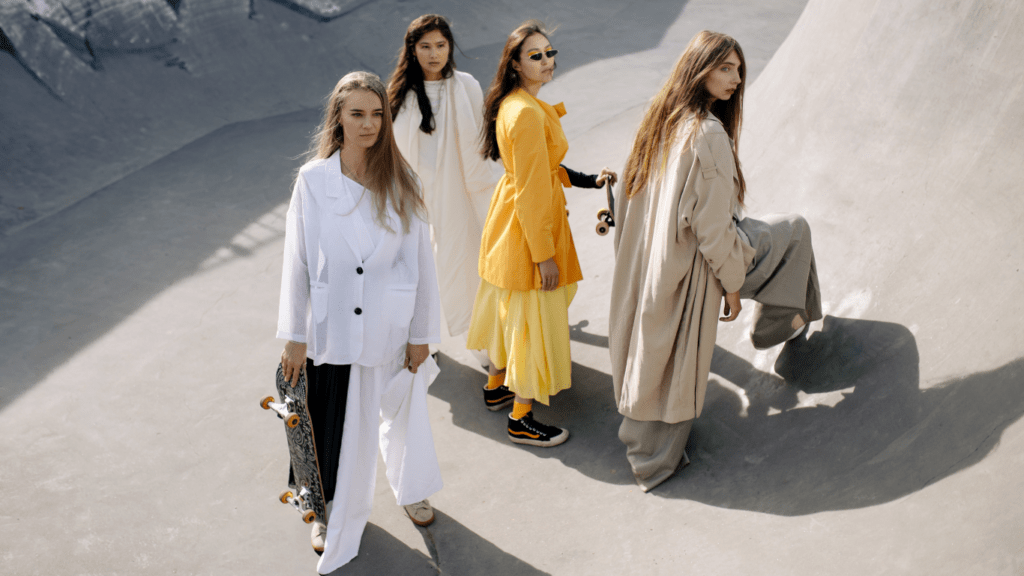The Evolution of Fashion Globalization
Fashion globalization has transformed significantly over the years, driven by advancements in technology and changes in consumer behavior. In the late 20th century, global brands began to emerge, spreading Western fashion to different parts of the world. With the rise of the internet in the early 2000s, access to diverse styles increased, allowing local designers to reach international markets.
Social media platforms like:
- TikTok
have played a crucial role in this evolution. Influencers showcase local trends to global audiences, bridging cultural gaps. These platforms enable real-time sharing of fashion innovations, making it easier for trends to go viral almost instantly.
E-commerce has further accelerated fashion globalization. Online retailers provide consumers access to various styles from around the world. Platforms like ASOS and Farfetch offer collections from multiple countries, expanding the reach of local trends.
Cultural collaborations have also become more common, blending elements from different regions to create unique fashion statements. Designers from Japan, Italy, and Nigeria, for example, collaborate to produce fusion collections, gaining global recognition.
Reduced production costs and faster shipping options have made international fashion more accessible. Factories in countries like China and Bangladesh produce high-quality garments affordably, making it possible for brands to distribute their products globally.
The increasing awareness of sustainability has also influenced fashion globalization. Consumers are more conscious of ethical fashion, seeking eco-friendly options from various parts of the world. Brands like Stella McCartney and Patagonia lead by example, promoting sustainable practices.
Globalization has turned fashion into a dynamic, interconnected industry where local trends become worldwide phenomena swiftly and effectively.
Cultural Influence on Global Fashion Trends
Cultural influence significantly impacts global fashion trends. Local traditions, historical garments, and fashionable capitals contribute to this dynamic interchange.
Traditional Garments Incorporated into Modern Wear
Designers often integrate traditional garments into contemporary fashion. For instance, Japanese kimonos inspire modern silhouettes, while Indian saris lend draped elegance to high-fashion gowns.
African prints commonly enhance streetwear, illustrating fashion’s blend of cultural heritage and modern trends. This fusion honors cultural roots while appealing to global tastes.
The Role of Fashion Capitals
Fashion capitals like Paris, Milan, New York, and London play pivotal roles in global fashion. These cities host premier fashion weeks, showcasing designers who set worldwide trends. Emerging cities like Tokyo and Seoul also influence fashion, introducing unique styles and trends. By merging local aesthetics with global elements, these capitals drive fashion globalization.
Technology and Fashion Globalization
Technology has revolutionized how fashion trends spread globally, making it easier for local styles to reach a worldwide audience. Two significant technological advancements, social media and e-commerce, have heavily influenced fashion globalization.
Social Media’s Impact on Trend Dissemination
Social media platforms play a crucial role in spreading fashion trends. Instagram and TikTok allow users to share local styles in real-time, sparking viral fashion movements. For instance, the “cottagecore” trend gained immense popularity through user-generated content on these platforms, transcending regional boundaries. Influencers and celebrities also amplify trends by showcasing outfits to millions of followers. These platforms democratize fashion by enabling anyone with an internet connection to participate in global fashion discourse.
E-commerce and Global Fashion Accessibility
- E-commerce platforms significantly enhance fashion accessibility.
- Websites like ASOS and Farfetch offer collections from designers worldwide, providing consumers access to unique styles.
- Advanced logistics and faster shipping options make it feasible to buy and receive goods from different countries swiftly.
- E-commerce also supports small and local brands in reaching an international market, fostering greater diversity in global fashion.
- The integration of augmented reality (AR) and virtual try-ons offers consumers a personalized shopping experience, bridging the gap between online and in-store shopping.
Economic Impacts of Globalized Fashion
Globalized fashion drives significant economic change by influencing production, distribution, and consumption patterns globally.
Fast Fashion and Global Markets

Fast fashion companies like Zara, H&M, and Uniqlo dominate global markets. They respond rapidly to changing trends, producing affordable apparel at high speeds.
These brands rely on international supply chains that use factories in countries with lower labor costs, such as Bangladesh and Vietnam. This model allows for reduced production costs and maximized profits. However, it often results in environmental and labor rights concerns.
Local Artisans and Global Demand
Artisans from regions like India, Africa, and South America have seen increased global demand for their traditional crafts. Companies and consumers worldwide seek unique, handmade pieces, leading to economic benefits for these local communities.
Websites like Etsy showcase and sell these products, providing artisans a global platform. While this integration into the global market can raise incomes, it may also threaten the preservation of traditional craftsmanship if scaled unsustainably.
Case Studies of Local Trends Going Global
Examining how local trends gain international traction offers insights into the fashion industry’s global dynamics. I will highlight notable examples under the following subheadings.
The Rise of Streetwear
Streetwear, originally rooted in the urban culture of 1980s New York City, has become a global fashion sensation. Brands like Supreme and A Bathing Ape (BAPE) grew from local niche labels into worldwide phenomena. Supreme, established in 1994, gained prominence through collaborations with major brands like Nike and Louis Vuitton. Their limited-edition releases, often referred to as “drops,” create a sense of urgency and exclusivity, fueling global demand.
Japanese streetwear also played a pivotal role. BAPE, founded by Nigo in 1993, merged Western and Eastern influences, soon capturing international attention. The brand’s distinctive camo patterns and shark hoodies became iconic. Social media, particularly Instagram, amplified the visibility of streetwear culture, enabling influencers and celebrities to showcase these styles to a global audience.
Sustainable Fashion Movements
Sustainable fashion, once a niche segment, now commands global interest. Movements like Slow Fashion, originating in Europe, advocate for considered purchasing and environmental responsibility.
Brands such as Stella McCartney and Patagonia lead this charge by emphasizing eco-friendly practices and materials. Stella McCartney’s commitment to sustainable luxury, using vegan leather and organic cotton, sets industry standards.
In Scandinavia, brands like Filippa K and Nudie Jeans epitomize sustainable style. Filippa K promotes a “wardrobe of longevity,” encouraging consumers to invest in timeless, high-quality pieces. Nudie Jeans focuses on organic denim and repair services, highlighting garment longevity. These practices resonate globally as consumers grow more eco-conscious, influencing other regions to adopt similar initiatives.
Examining these case studies reveals how local trends, whether streetwear or sustainable fashion, resonate globally. Enhanced visibility through social media and strategic brand collaborations often drive their international success.



 Founder & Editor-in-Chief
As the visionary behind Glam World Walk, Anthonyo Corbinollo brings his passion for fashion, beauty, and luxury to life through captivating content that resonates with glamour enthusiasts worldwide. With over a decade of experience in the fashion industry, Anthonyo curates a platform that celebrates the finest trends, exclusive brands, and lavish travel destinations. His dedication to highlighting the elegance in everyday life has made Glam World Walk a go-to source for fashionistas and style icons alike.
Founder & Editor-in-Chief
As the visionary behind Glam World Walk, Anthonyo Corbinollo brings his passion for fashion, beauty, and luxury to life through captivating content that resonates with glamour enthusiasts worldwide. With over a decade of experience in the fashion industry, Anthonyo curates a platform that celebrates the finest trends, exclusive brands, and lavish travel destinations. His dedication to highlighting the elegance in everyday life has made Glam World Walk a go-to source for fashionistas and style icons alike.
